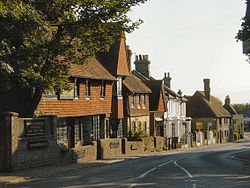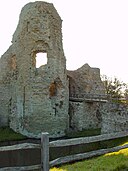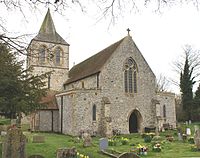Pevensey
| Pevensey | |
| Sussex | |
|---|---|
 Pevensey High Street | |
| Location | |
| Grid reference: | TQ635052 |
| Location: | 50°49’13"N, 0°20’18"E |
| Data | |
| Population: | 3,152 (2007 est.) |
| Post town: | Pevensey |
| Postcode: | BN24 |
| Dialling code: | 01323 |
| Local Government | |
| Council: | Wealden |
| Parliamentary constituency: |
Bexhill and Battle |
| Website: | Pevensey Parish Council |
Pevensey is a village in Sussex, in the south-east of the county: it used to be a seaside village, before the coastline retreated and left Pevensey's harbour high and dry.
The main village is now a mile inland from Pevensey Bay, and 5 miles north-east of Eastbourne. A hamlet named Pevensey Bay does sit on the coast and forms part of the parish.
Pevensey's dramatic place is history is that it was here that William the Bastard, Duke of Normandy, first landed when he invaded England in 1066.
Contents
Name
The name Pevensey was first recorded in 947 as Pefenesea, meaning "Pefen's River", after an otherwise unknown local lord or landowner. This is presumably a reference to the now largely silted-up Pevensey Haven.[1]
A more familiar Anglo-Saxon name presumed to refer to Pevensey itself is Andredes ceaster and variant forms, which is taken from the British language name for the place reflected in the Roman Anderitum. The name is found also as the name of a forest of Sussex and Kenrt known variously as Andred and Andredes leg.[2]
Geography
Pevensey stands on a spur of sand and clay, about thirty feet above sea level. In Roman times this spur was a peninsula that projected into a tidal lagoon and marshes. A small river, Pevensey Haven, runs along the north side of the peninsula and would originally have discharged into the lagoon, but is now largely silted up.[3] The lagoon extended inland as far north as Hailsham and eastwards to Hooe. With the effect of longshore drift this large bay was gradually cut off from the sea by shingle, so that today's marshes are all that remain behind the shingle beach.
The marshes, known as the Pevensey Levels, cover an area of around 47 square miles. They are a Site of Special Scientific Interest[4] and form a large nature reserve, jointly owned by Natural England and the Sussex Wildlife Trust.[5] There are many nationally rare plants and invertebrates, including the fen raft spider. The site is very fragile and general access is not permitted.
Pevensey Bay
Pevensey Bay hamlet sits behind and on the shingle beach. Although small, it is nevertheless a seaside resort in miniature, and has many of the facilities of its larger counterparts elsewhere.
History
The Roman fort
By the 4th century when the south and east of the province of Britannia were under frequent attack from marauding Germanic tribes, the Romans built a fort at Pevensey, one of eleven forts between Essex and the Isle of Wight now known as the Saxon Shore Forts. The fort at Pevensey was built between 300–340 and was named Anderitum. The earliest stone remains on the site date from the Roman period, including the outer bailey wall. The sea washed over what is now Pevensey Marshes, surrounding the fort on three sides.
In the late fifth century, Saxons, possibly led by Ælle of Sussex began to colonise the south coast and besieged Anderitum.[2] This was the foundation of the Kingdom of the South Saxons, now known as Sussex. The old Roman fort of Anderida was burned and left derelict. For a while the ruined castle was known by the Saxons as Andredceaster and the Weald of southern Britain - which stretches 120 miles from Anderida to Dorset - was named Andredsweald, the Forest of Anderida.
The fort probably remained derelict until, in 1042, Harold Godwinson, later King Harold II, established a stronghold here, improving fortifications by digging ditches within the walls of the fort. The English army remained at the fort during the summer of 1066 before abandoning it to meet the invading Norwegians further north.
When William the Conqueror invaded Sussex in September 1066 there were no defenders at Pevensey and the bay provided a safe haven for the invading fleet.[6]
The castle
- Main article: Pevensey Castle
In late 1066 the Roman fort at Pevensey was occupied by the Normans; much of the Roman stonework still existing today is due largely to the work of Robert, Count of Mortain (half brother to William), who was granted Pevensey Castle shortly after the Norman Conquest. Robert de Mortain used the remains as the base for building his castle, carrying out only minor repairs to the walls forming the outer bailey, and building a new inner bailey at the eastern end.
The castle was besieged several times during the 11th–13th centuries. An order by Queen Elizabeth I that it be demolished and an attempt at demolition during the Puritan times were both unsuccessful: the order was ignored and only a few stones were removed on the two occasions. As late as 1942 small additions were made to the castle for the defence of Britain, when it became a lookout over the channel for German aircraft during Second World War.
Today the castle is in the care of English Heritage.[7]
The Liberty of Pevensey
The Liberty (or Lowey) of Pevensey is a hundred within the Pevensey Rape of Sussex, containing the parishes of Westham and Pevensey. They are entirely within the Pevensey Levels and together were regarded as constituting part of the port of Hastings, and consequently would be entitled to all the privileges and immunities enjoyed by the Cinque Ports excluded from the jurisdiction of the justices of Sussex.[8]
Other historic events
In the 16th century Pevensey became what was known as a "non-corporate limb" of the Hastings, as part of the Confederation of the Cinque Ports. Along with most of the other Ports, its importance dwindled as the ports themselves became disconnected from the sea: Pevensey was two miles distant.
During the 18th and 19th centuries Pevensey Bay became involved in south coast smuggling, since it was one of the easier places to land the contraband. In 1833 a violent clash occurred between the smugglers and customs men at Pevensey Bay.[9]
Some of the more than 100 Martello towers were erected along the beaches of Pevensey Bay at the beginning of the 19th century against Napoleonic attack.
Churches
The churches and chapels in the parish are:
- Church of England:
- St Nicolas's Church, Pevensey
- St Wilfrid's Church, Pevensey Bay
- Independent / evangelical: Pevensey Bay Free Church
- Methodist church
- Roman Catholic: Holy Rood, Pevensey Bay.
Culture
Pevensey in the arts
- J.M.W. Turner painted Pevensey Castle.
- Pevensey features several times in Rudyard Kipling's Puck of Pook's Hill (1907). Kipling's characters describe it as "England's Gate", the reason for this being the above history. Kipling lived near to Pevensey at Burwash, and the area is described in his autobiography.
- Pevensey features in The Saxon Shore (1983), a book of photographs by famous photographer Fay Godwin.
- Pevensey is the setting for parts of George Gissing's 1887 novel Thyrza, with an especially fine description in Chapter XLI, "The Living".
- Robert Sheldon composed Pevensey Castle, published by C L Barnhouse in 1993.
- Pevensey, and in particular Pevensey Bay, feature in the 1946 crime novel "Uneasy Terms" by best selling author Peter Cheyney. In Chapter 7 the hero, a private detective called Slim Callaghan, goes for a ride out on Pevensey Bay with the alluring murder suspect, Corinne Alardyse.
- The Pevensies in the Narnia stories were named after the town.
- Pevensey Bay was the landing place of Gibreel Farishta and Saladin Chamcha in Salman Rushdie's Satanic Verses.[10]
Sport
Pevensey Bay Sailing Club[11] offers a variety of classes of boats: the club played a leading role in the development of the National 12 and Merlin Rocket Development Class racing dinghies in the 1970s when it was the home club of Phil Morrison, the British yacht designer.
Outside links
| ("Wikimedia Commons" has material about Pevensey) |
References
- ↑ Mills, David (2011). A Dictionary of British Place-Names. Oxford University Press. p. 367. ISBN 9780199609086.
- ↑ 2.0 2.1 Anglo-Saxon Chronicle Laud Chronicle (477) Her com Ælle on Brytenland [. . .] 7 þær ofslogon manige Walas. 7 sume on fleame bedrifon on þone wudu þe is nemned Andredes lege. ("In this year came Ælle to Britain [. . .] and there slew many Britons and some in flight drove into the wood named Andredes leg")
- ↑ Lyne, Malcolm (2009). Excavations at Pevensey Castle, 1936 to 1964. Oxford: Archaeopress. p. 6. ISBN 9781407306292.
- ↑ SSSI listing and designation for Pevensey Levels
- ↑ The Pevensey Levels nature reserve
- ↑ [1] This source suggests that he landed at the mouth of Coombe Haven nearer Hastings, establishing a wooden fort on what is now the site of Wilting Manor in Crowhurst. This might explain why the battlefield was at Senlac, north of Hastings, and not nearer Pevensey. (Secrets of the Norman Invasion by Nick Austin)
- ↑ Pevensey Castle
- ↑ Horsfield, Thomas Walker (1834). The History, Antiquities and Topography of the County of Sussex. Bakewell: Country Books. ISBN 978-1-906789-16-9 pp.269-424 Pevensey Rape
- ↑ Martello Beach website
- ↑ Rushdie, Salman (2012). Joseph Anton.
- ↑ Pevensey Bay Sailing Club

